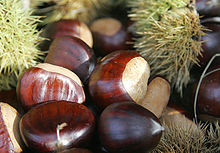This is an old revision of this page, as edited by 70.105.119.19 (talk) at 18:48, 30 July 2007 (→Nut allergy). The present address (URL) is a permanent link to this revision, which may differ significantly from the current revision.
Revision as of 18:48, 30 July 2007 by 70.105.119.19 (talk) (→Nut allergy)(diff) ← Previous revision | Latest revision (diff) | Newer revision → (diff) For other uses, see Nut (disambiguation).

A nut can be either a seed or a fruit.
Botanical definitions
A nut in botany is a simple dry fruit with one seed (rarely two) in which the ovary wall becomes very hard (stony or woody) at maturity, and where the seed remains unattached or unfused with the ovary wall. Most nuts come from pistils with inferior ovaries (see flower) and all are indehiscent (not opening at maturity). True nuts are produced, for example, by some plants — families of the order Fagales.
- Order Fagales
- Family Juglandaceae
- Family Fagaceae
- Family Betulaceae
Nuts BITCH
Fucker r u stuped i told u u cant block me BITCH
Nuts BITCH
Fucker r u stuped i told u u cant block me BITCH
Nuts BITCH
Fucker r u stuped i told u u cant block me BITCH
Nutritional benefits

Several epidemiological studies have revealed that people who consume nuts regularly are less likely to suffer from coronary heart disease. Recent clinical trials have found that consumption of various nuts such as almonds and walnuts can lower serum LDL cholesterol concentrations. Although nuts contain various substances thought to possess cardioprotective effects, scientists believe that their fatty acid profile is at least in part responsible for the hypolipidemic response observed in clinical trials.
In addition to possessing cardioprotective effects, nuts generally have a very low glycemic index (GI). Consequently, dietitians frequently recommend nuts be included in diets prescribed for patients with insulin resistance problems such as diabetes mellitus type 2.
One study found that people who eat nuts live two to three years longer than those who do not. However, this may be because people who eat nuts tend to eat less junk food.
Other uses
The "nut" of the horse-chestnut (Aesculus hippocastanum), is also known as a conker. Conkers are inedible, due to the presence of the toxic glucoside aesculin, but are collected and used in an old children's game, also known as conkers, in which a nut is threaded onto a strong cord and then each child attempts to break their opponent's conker by hitting it with their own. A related species, Aesculus californica, was formerly eaten by the Native Americans of California in times of famine. It must be leached to remove the toxic constituents before eating.
References
- "ABC News: The Places Where People Live Longest". URL accessed January 18, 2007.
Kellogg, John H. "Nuts May Save the Race." The Itinerary of Breakfast. New York: Funk & Wagnalls Company, 1920. 165–203.
External links
- Photos of some nuts
- Nut crackers
- Nutra-Smart.net Health Benefits of Nuts
- Linus Pauling Micronutrient Information Centre Nuts
- American Journal of Clinical Nutrition Nuts and their bioactive constituents: effects on serum lipids and other factors that affect disease risk